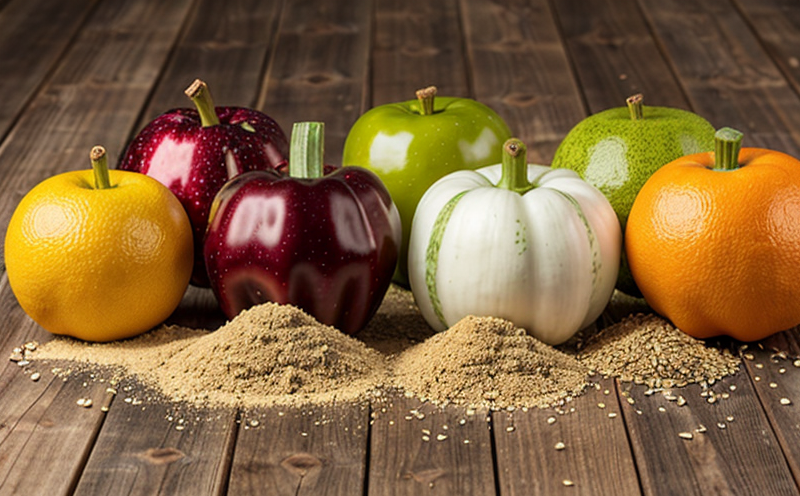ISO 4832 Coliform Bacteria Testing in Fruits and Vegetables
The ISO 4832 standard provides a robust method for the detection of coliform bacteria, which are an important indicator of potential contamination by human or animal waste. This is particularly crucial in the fruit, vegetable, and grain sectors where food safety is paramount. Coliforms are a family of bacteria that include Escherichia coli (E. coli), Enterococcus, and Klebsiella species. Their presence can indicate the presence of pathogenic microorganisms, thus making coliform testing an essential quality assurance step.
The procedure outlined in ISO 4832 involves the use of membrane filtration to concentrate the sample, followed by incubation on a selective medium. The countable colonies that grow are then identified as coliforms. This method is highly sensitive and specific, providing accurate results even when dealing with complex matrices such as fruits and vegetables.
For fruits and vegetables, it is essential to ensure that no external contaminants enter the food chain. Therefore, this testing protocol plays a vital role in maintaining high standards of hygiene and ensuring consumer safety. Compliance with ISO 4832 is not only a measure of quality assurance but also an integral part of sustainability initiatives aimed at reducing foodborne illnesses.
Compliance with international standards like ISO 4832 ensures that the products meet global market requirements, thereby enhancing exportability and market access. This standardization contributes significantly to the sector's ability to compete in a global marketplace by ensuring consistent quality across different regions.
The testing process involves several steps: sampling, sample preparation, inoculation of the selective medium, incubation, and final enumeration. Each step is critical in ensuring that the results are accurate and reliable. For instance, proper sampling techniques ensure that representative samples are collected from various parts of the fruit or vegetable to reflect the overall quality and safety.
Sample preparation involves washing the produce with distilled water and then performing a membrane filtration process. This step removes any particulate matter, ensuring that only viable bacteria remain on the membrane filter. The inoculated filter is then placed onto MacConkey Agar or M-Endo agar, which selectively grows coliforms.
The incubation period for these media varies depending on the temperature and humidity conditions. Typically, incubation occurs at 36°C ± 1°C for 24 to 48 hours under aerobic conditions. During this time, any coliform bacteria present in the sample will grow into visible colonies that can be counted.
Once the colonies have reached a suitable countable range (typically between 30 and 300), they are transferred to a secondary medium for confirmation testing. This step ensures that only true coliforms are reported, eliminating any false positives that may arise from non-coliform bacteria.
The results of ISO 4832 testing provide critical information about the sanitary quality of fruits and vegetables. This data is used by food safety managers to make informed decisions regarding product quality, packaging, storage, and distribution. By adhering to this standard, producers can ensure that their products meet stringent hygiene standards, thereby enhancing consumer confidence in the brand.
Compliance with ISO 4832 also supports sustainability efforts within the agricultural sector by minimizing waste and reducing the risk of contamination. This, in turn, helps protect both the environment and public health. The use of this standard contributes to a more resilient food supply chain that can withstand fluctuations in global markets.
In conclusion, ISO 4832 Coliform Bacteria Testing is an indispensable tool for ensuring the safety and quality of fruits and vegetables. By adhering to this international standard, producers and processors demonstrate their commitment to consumer health and satisfaction while also contributing to broader sustainability goals.
International Acceptance and Recognition
- The ISO 4832 method is widely accepted in countries around the world, including those that are signatories of the Codex Alimentarius, a joint venture between the World Health Organization (WHO) and the Food and Agriculture Organization (FAO).
- This standard is recognized by regulatory bodies such as the United States Department of Agriculture (USDA), the European Commission, and the Canadian Food Inspection Agency.
By adhering to ISO 4832, food producers can ensure that their products meet global standards and are therefore more likely to gain acceptance in international markets. This standardization not only enhances exportability but also fosters trust among consumers who value high-quality produce.
Environmental and Sustainability Contributions
The practice of conducting ISO 4832 Coliform Bacteria Testing in fruits and vegetables contributes significantly to environmental sustainability by reducing the risk of contamination. By ensuring that produce is free from harmful bacteria, this testing helps prevent foodborne illnesses, which can have severe health implications for consumers.
Moreover, compliance with international standards like ISO 4832 encourages sustainable agricultural practices. Farmers who adhere to these guidelines are better equipped to manage their resources efficiently and minimize waste. This not only reduces the environmental impact of farming operations but also promotes long-term economic stability within the sector.
The use of advanced testing methods such as ISO 4832 also supports the development of more resilient food supply chains. By identifying potential contamination early in the production process, these tests allow for corrective actions to be taken promptly, reducing the likelihood of widespread outbreaks and recalls.
Use Cases and Application Examples
- Quality Assurance: ISO 4832 testing is used by food processors to ensure that their products meet stringent hygiene standards. This helps maintain consumer trust and loyalty.
- Export Compliance: Many countries require imports of fruits and vegetables to be tested for coliform bacteria as a condition for entry into the market. ISO 4832 provides a standardized method that meets these requirements.
- R&D Initiatives: Researchers use this testing protocol to develop new varieties of fruits and vegetables that are more resistant to contamination. This supports innovation in the agricultural sector.
In addition, this testing is crucial during outbreaks of foodborne illnesses. By identifying contaminated batches early, producers can take corrective action, preventing further spread of pathogens. This proactive approach helps protect public health and reduces the burden on healthcare systems.





